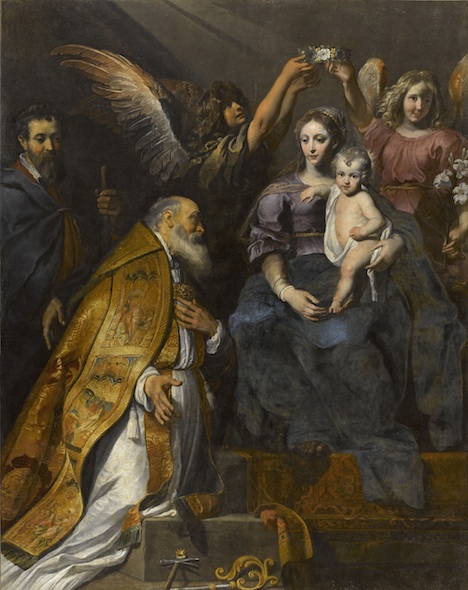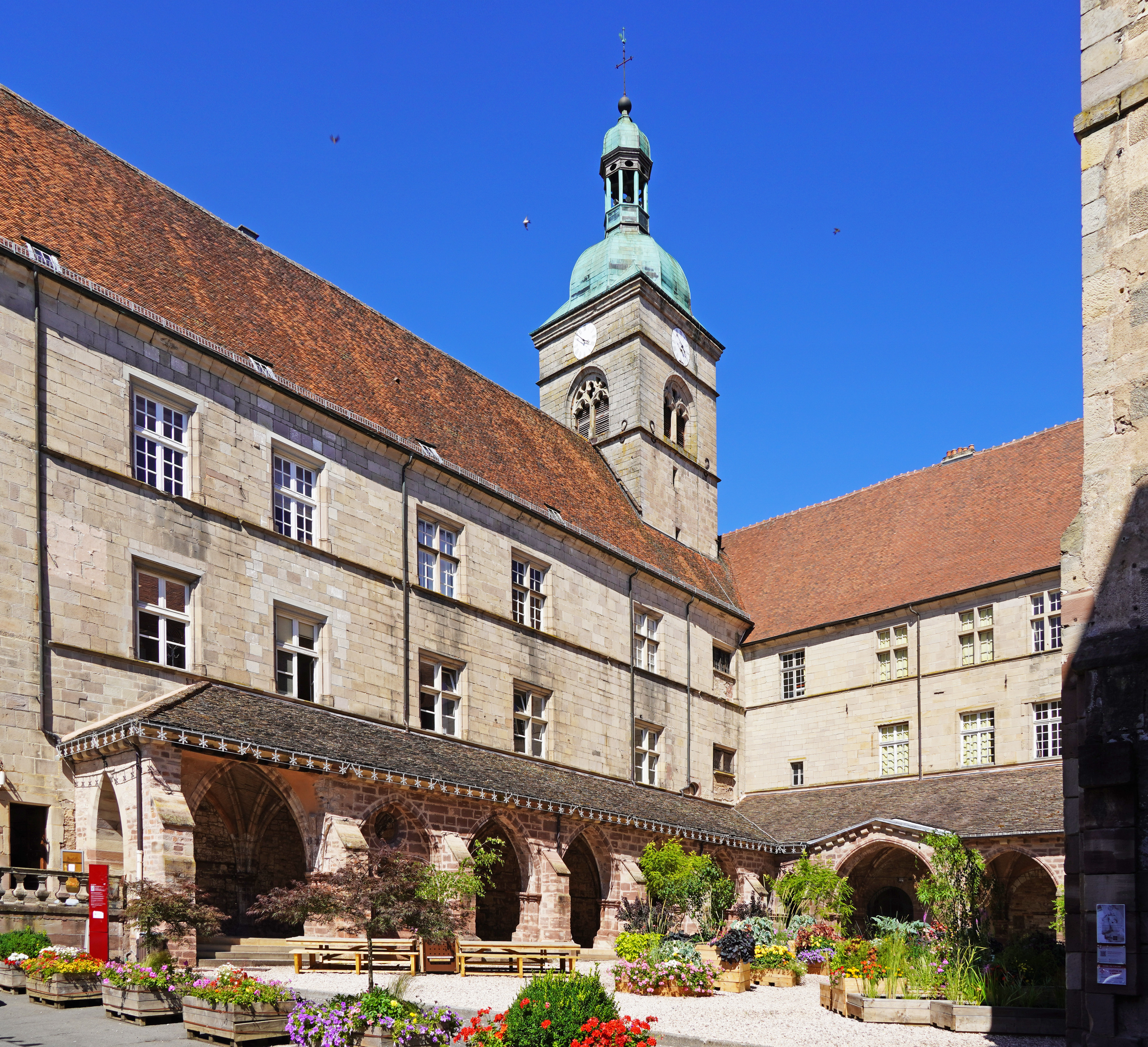|
Acarius
Saint Acarius (died 14 March 642) was a monk of Luxeuil Abbey, who became bishop of Doornik and Noyon, which today are located on either side of the Franco-Belgian border. Life Acarius was born to a noble family of Burgundy. He entered the Abbey of Luxeuil and was a pupil of Abbot Eustace. Audomar, future bishop of Thérouanne was a classmate. While the date of his election is not known, it is assured that he was bishop of Doornik and Noyon in 627. He was an adviser to King Clothar II. Apparently, Acarius had great influence on the spreading of Christianity in Belgic Gaul. It was Acarius that recommended to Dagobert that Audomar be appointed Bishop of Thérouanne. He was a strong supporter of the missionary Amandus, but despite his influence could not prevent King Dagobert I from banishing Amandus for chastising him. Amandus then went to Gascony. Along with Audomar and the King's counselor, Éloi, they were eventually able to persuade Dagobert to allow Amandus to return, and ... [...More Info...] [...Related Items...] OR: [Wikipedia] [Google] [Baidu] |
639 Deaths
__NOTOC__ Year 639 ( DCXXXIX) was a common year starting on Friday (link will display the full calendar) of the Julian calendar. The denomination 639 for this year has been used since the early medieval period, when the Anno Domini calendar era became the prevalent method in Europe for naming years. Events By place Europe * January 19 – Dagobert I dies after a 10-year reign as king of all the Franks, in which his realm has prospered. He is succeeded by Sigebert III (age 9), independent ruler of Austrasia, and his half-brother Clovis II (age 2), who becomes king of Neustria and Burgundy. Under the supervision of Pepin of Landen, Mayor of the Palace, the royal treasury is distributed between the two brothers and widowed queen Nanthild (regent on Clovis' behalf). Arabian Empire * Arab–Byzantine War: The Rashidun army (4,000 men), under the command of 'Amr ibn al-'As, invades Byzantine Egypt. They capture the strategic town of Pelusium (Nile Delta) after a two- ... [...More Info...] [...Related Items...] OR: [Wikipedia] [Google] [Baidu] |
Bishop Of Doornik And Noyon
The Diocese of Tournai is a Latin Church ecclesiastical territory or diocese of the Catholic Church in Belgium. The diocese was formed in 1146, upon the dissolution of the Diocese of Noyon & Tournai, which had existed since the 7th Century. It is now suffragan in the ecclesiastical province of the metropolitan Archdiocese of Mechelen-Brussels. The cathedra is found within the Cathedral of Notre-Dame de Tournai, which has been classified both as a major site for Wallonia's heritage since 1936 and as a World Heritage Site since 2000. History As early as the second half of the 3rd century St. Piat evangelized Tournai; some sources name him as the first bishop, but this remains unsubstantiated. At the end of the 3rd century Emperor Maximian rekindled persecutions, and St. Piat was martyred as a result.Warichez ... [...More Info...] [...Related Items...] OR: [Wikipedia] [Google] [Baidu] |
Saint Eligius
Saint Eligius (also Eloy, Eloi or Loye; french: Éloi; 11 June 588 – 1 December 660 AD) is the patron saint of goldsmiths, other metalworkers, and coin collectors. He is also the patron saint of veterinarians, the Royal Electrical and Mechanical Engineers ( REME), a corps of the British Army, but he is best known for being the patron saint of horses and those who work with them. Eligius was chief counsellor to Dagobert I, Merovingian king of France. Appointed the bishop of Noyon-Tournai three years after the king's death in 642, Eligius worked for 20 years to convert the pagan population of Flanders to Christianity. Biography Eligius was born at the villa of Captelat, six miles north of Limoges, in Aquitaine (now France), into an educated and influential Gallo-Roman family. His father, recognising unusual talent in his son, sent him to the goldsmith Abbo, master of the mint at Limoges. Later Eligius went to Neustria, the palace of the Franks, where he worked under Babo, the ... [...More Info...] [...Related Items...] OR: [Wikipedia] [Google] [Baidu] |
Eustace Of Luxeuil
Eustace of Luxeuil (c. 560 – c. 626), also known as Eustasius, was the second abbot of Luxeuil from 611. He succeeded his teacher Columbanus, to whom he had been a favorite disciple and monk. He had been the head of the monastic school. Life Eustace was born in Burgundy and became a monk at Luxeuil. When Columbanus, the founder of Luxeuil, was banished from the Kingdom of Burgundy, on account of his reproving the morals of King Theuderic II, he recommended his community choose Eustace as his successor. Subsequently, Columbanus settled at Bobbio in Italy. After the death of Theuderic, Clothaire II sent Eustace to Bobbio to ask Columbanus to return, but the exiled abbot declined. [...More Info...] [...Related Items...] OR: [Wikipedia] [Google] [Baidu] |
Amandus
Amandus ( 584 – 679), commonly called Saint Amand, was a bishop of Tongeren-Maastricht and one of the great Christian missionaries of Flanders. He is venerated as a saint, particularly in France and Belgium. Life The chief source of details of his life is the ''Vita Sancti Amandi'', an eighth-century text attributed to Beaudemond ( la, Baudemundus). The vita was expanded by Philippe, abbot of Aumône. According to this biography, Amand was born in Lower Poitou. He was of noble birth but at the age of twenty, he became a monk on the Île d'Yeu, against the wishes of his family. His father threatened to disinherit him if he did not return home. From there Amandus went to Bourges and became a pupil of bishop Austregisilus. There he lived in solitude in a cell for fifteen years, living on no more than bread and water.Campbell, Thomas (1907). "St. Amandus", ''The Catholic Encyclopedia''. Vol. 1. New York: Robert Appleton Company. Humbert of Maroilles was of a noble family and tra ... [...More Info...] [...Related Items...] OR: [Wikipedia] [Google] [Baidu] |
Luxeuil Abbey
Luxeuil Abbey (), the ''Abbaye Saint-Pierre et Saint-Paul'', was one of the oldest and best-known monasteries in Burgundy, located in what is now the département of Haute-Saône in Franche-Comté, France. History Columbanus It was founded circa 590 by the Irish missionary Saint Columbanus. Columbanus and his companions first settled in cells at Annegray, in the commune of Voivre, Haute-Saône. Looking for a more permanent site for his community, Columbanus decided upon the ruins of a well-fortified Gallo-Roman settlement, ''Luxovium'', about eight miles away. The Roman town had been ravaged by Attila in 451, and was now buried in the dense overgrown woodland that had filled the abandoned site over more than a century, but the place still had the advantage of the thermal baths ("constructed with unusual skill", according to Columbanus' early biographer, Jonas of Bobbio) down in the valley, which still give the town its name of Luxeuil-les-Bains. Jonas described it further: "The ... [...More Info...] [...Related Items...] OR: [Wikipedia] [Google] [Baidu] |
Saint
In religious belief, a saint is a person who is recognized as having an exceptional degree of Q-D-Š, holiness, likeness, or closeness to God. However, the use of the term ''saint'' depends on the context and Christian denomination, denomination. In Catholic Church, Catholic, Eastern Orthodox Church, Eastern Orthodox, Anglican Communion, Anglican, Oriental Orthodox, and Lutheranism, Lutheran doctrine, all of their faithful deceased in Heaven are considered to be saints, but some are considered worthy of greater honor or emulation. Official ecclesiastical recognition, and consequently a public cult of veneration, is conferred on some denominational saints through the process of canonization in the Catholic Church or glorification in the Eastern Orthodox Church after their approval. While the English word ''saint'' originated in Christianity, History of religion, historians of religion tend to use the appellation "in a more general way to refer to the state of special holiness t ... [...More Info...] [...Related Items...] OR: [Wikipedia] [Google] [Baidu] |
Bishops Of Tournai
A bishop is an ordained clergy member who is entrusted with a position of authority and oversight in a religious institution. In Christianity, bishops are normally responsible for the governance of dioceses. The role or office of bishop is called episcopacy. Organizationally, several Christian denominations utilize ecclesiastical structures that call for the position of bishops, while other denominations have dispensed with this office, seeing it as a symbol of power. Bishops have also exercised political authority. Traditionally, bishops claim apostolic succession, a direct historical lineage dating back to the original Twelve Apostles or Saint Paul. The bishops are by doctrine understood as those who possess the full priesthood given by Jesus Christ, and therefore may ordain other clergy, including other bishops. A person ordained as a deacon, priest (i.e. presbyter), and then bishop is understood to hold the fullness of the ministerial priesthood, given responsibility b ... [...More Info...] [...Related Items...] OR: [Wikipedia] [Google] [Baidu] |
7th-century Frankish Bishops
The 7th century is the period from 601 (DCI) through 700 ( DCC) in accordance with the Julian calendar in the Common Era. The spread of Islam and the Muslim conquests began with the unification of Arabia by Muhammad starting in 622. After Muhammad's death in 632, Islam expanded beyond the Arabian Peninsula under the Rashidun Caliphate (632–661) and the Umayyad Caliphate (661–750). The Muslim conquest of Persia in the 7th century led to the downfall of the Sasanian Empire. Also conquered during the 7th century were Syria, Palestine, Armenia, Egypt, and North Africa. The Byzantine Empire suffered setbacks during the rapid expansion of the Caliphate, a mass incursion of Slavs in the Balkans which reduced its territorial limits. The decisive victory at the Siege of Constantinople in the 670s led the empire to retain Asia Minor which assured the existence of the empire. In the Iberian Peninsula, the 7th century was known as the ''Siglo de Concilios'' (century of councils) refe ... [...More Info...] [...Related Items...] OR: [Wikipedia] [Google] [Baidu] |
Belgian Roman Catholic Saints
Belgian may refer to: * Something of, or related to, Belgium * Belgians, people from Belgium or of Belgian descent * Languages of Belgium, languages spoken in Belgium, such as Dutch, French, and German *Ancient Belgian language, an extinct language formerly spoken in Gallia Belgica *Belgian Dutch or Flemish, a variant of Dutch *Belgian French, a variant of French *Belgian horse (other), various breeds of horse *Belgian waffle, in culinary contexts * SS ''Belgian'', a cargo ship in service with F Leyland & Co Ltd from 1919 to 1934 *''The Belgian'', a 1917 American silent film See also * *Belgica (other) Gallia Belgica was a province of the Roman Empire in present-day Belgium, Luxembourg, and the Netherlands. Belgica may also refer to: Places * Belgica Glacier, Antarctica * Belgica Guyot, an undersea tablemount off Antarctica * Belgica Mounta ... * Belgic (other) {{Disambiguation ... [...More Info...] [...Related Items...] OR: [Wikipedia] [Google] [Baidu] |
Wikisource
Wikisource is an online digital library of free-content textual sources on a wiki, operated by the Wikimedia Foundation. Wikisource is the name of the project as a whole and the name for each instance of that project (each instance usually representing a different language); multiple Wikisources make up the overall project of Wikisource. The project's aim is to host all forms of free text, in many languages, and translations. Originally conceived as an archive to store useful or important historical texts (its first text was the ), it has expanded to become a general-content library. The project officially began on November 24, 2003 under the name Project Sourceberg, a play on the famous Project Gutenberg. The name Wikisource was adopted later that year and it received its own domain name. The project holds works that are either in the public domain or freely licensed; professionally published works or historical source documents, not vanity products. Verification was initi ... [...More Info...] [...Related Items...] OR: [Wikipedia] [Google] [Baidu] |


.jpg)



